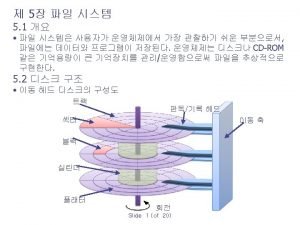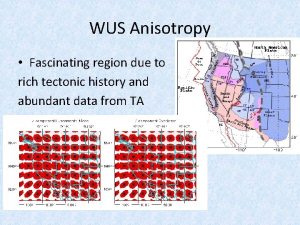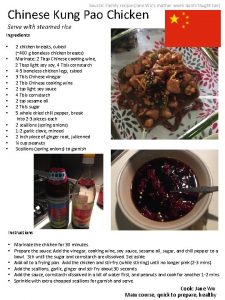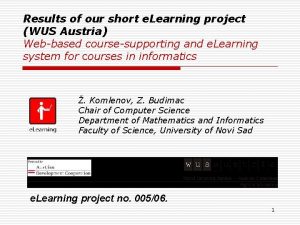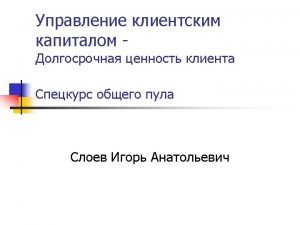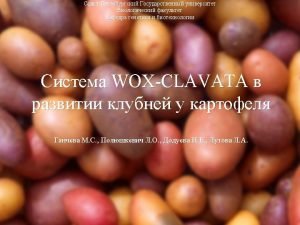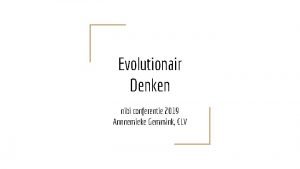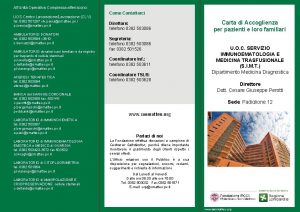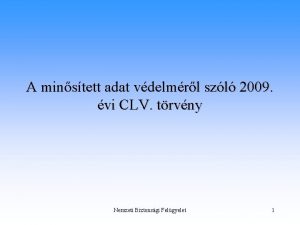17 18 19 20 WUS CLV 3 CLV
































































- Slides: 64

























17 18 19 20













WUS CLV 3 CLV 1/CLV 2 BAM 1/BAM 2 CLV 3 is a secreted CLE-domain peptide。 CLV 1/CLV 2和BAM 1/BAM 2是含有LRR域的激酶。 BAM 1/BAM 2是与CLV 1相关的蛋白 Possibly founction by sequestering CLV 3


大量细胞被召集 到注定要成为花 Floral Meristem Specification and Determination 分生组织的部分 Four founder cells—— confocal laser scanning microscopy More founder cells—— sector boundary analysis Expressing LFY, some form bract , some form floral meristem CUP-SHAPED -COTYLEDON 2 (CUC 2)在纬度方向上表达,即围绕 原基的四周,在花原基和IM形成第 二个分界。 调节物包括一个mi. RNA在内。

IM genes 环境 信号 体内 信号 TERMINAL FLOWER 1(TFL 1) EMBRYONIC FLOWER 1 and 2 (EMF 1和2) 例如:如果TFL 1或EMF 1或 EMF 2突变,LFY、AP 1同时或 者LFY使IM转变为FM 反过来,如果AP 1,CAL, LFY被抑制,FM就有了IM 的 特征。 花诱导 GRN LFY FMI genes APETALA 1(AP 1) APETALA 2(AP 2) CAULIFLOWER(CAL)


EMF genes �对营养生长有重要作用,但对开花时间和花序发育也 有调控作用。 � Loss-of-function mutants in these genes produce flowers immediately after germination skipping the vegetative phase �EMF 1编码一个抑制AP 1的蛋白,但对LFY 没有作用 �EMF 2编码一个异常的锌指蛋白,属于多梳蛋白家族

LFY � LFY is necessary and sufficient to specify FMI. � In lfy mutants, leaves and secondary shoots are produced instead of flowers. � LFY overexpression causes the conversion of leaves and axillary LFY蛋白浓度在FM中一致,很可能是因为它在细胞之间 meristems to flowers. 可以移动。 外部信号 (春化作用 和光等) 内部信号 (赤霉素GA) 强烈表达并 转化SAM为 IM

AP 1 CAL FUL �AP 1在建设FM时,与LFY有重叠的功能。 AP 1 突变基因 AP 1 LFY AP 1或LFY过表 达 几乎把花完全转 CAL: AP 1最近的旁系同源基因, 突变性状 有花序特点的茎 引起终端成为花 化为茎 FUL: 位于MADS-box系统发育树内相同基因进化分枝上 Acting redundantly to AP 1 in FM specification; 突变基因 性状 CAL FUL Not showing any FMI disorders CAL/AP 1 FUL/AP 1 CAL/FUL/AP 1 The ap 1 phenotype is greatly intensified。


FT: a homolog of TFL 1 FD: a b. Zip transcription factor Paradoxically, during the establishment of the FM, genes like TFL 1 and EMF 1 that help to maintain the IM identity are also expressed, keeping the expression of the FMI genes out of the IM。

Maintainance of determinate floral meristem �lfy-6的杂合体和ag-1的纯合体导致花的reversion。 LFY PERIANTHIA(PAN ) WUS Induction AG KNUCKLES(KNU) Positively regulating ULT KNU represses WUS expression to terminate the stem cell niche after a limited number of organs have been formed。


与激素的关系 �STM能促进cytokinin(CK)的合成和积累,抑制GA产生。 �WUS能通过抑制ARABIDOPSIS TYPE A RESPONSE REGULATORS (ARRs)来激活CK。 STM CUC 高CK:auxin 低GA 高auxin浓度 低CK:auxin 高GA




A genes AP 1 Important for the establishment of sepal and petal identity as well as the FM。 Positive feedback for maintaining B genes Mutation in genes Strong AP 1 allele Weaker AP 1 allele Phenotype Lacking petals Not full conversion of floral organs

AP 2 Not MADS-box genes; The expression pattern of AP 2 does not correlate with the site where it exerts its function in floral organ identity. whorls 3 and 4 All whorls mi. R 172 AG AP 2 突变后可加强ap 1和lfy的突变表型。 AP 3, PI

B genes AP 3 PI The fact that both single mutants yield the same phenotype shows their interdependence. Flowering signals induce LFY /UFO ANT (AP 2 gene family) induce B genes Repress FT AP 1 Repress EBS (EARLY BOLTING IN SHORT DAYS) The proteins encoded by these two genes form heterodimers to exert their B function during petal and stamen development. This oligomerization is necessary for them to move into the nucleus.

C genes AG Important for floral meristem determinancy, besides its role in stamen and carpel identity. The regulation of AG has been much studied; at least ten proteins repress and five activate it to maintain its expression in the appropriate whorl. Repressors LEUNIG (LUG)/ SEUSS (SEU) LEUNIG_HOMOLOG (LUH) BELLRINGER (BLR) histone acetyltransferase GCN 5 RABBIT EARS (RBE) ANT STERILEAPETALA (SAP) AP 1 and SEP 3’s help AG Second intron Activators ENHANCER OF AG-4 (HUA) HUA ENHANCER (HEN) Post-transcriptional level


ABC 基因调节特点 l The ABC proteins exert their regulatory function as multimers. Example: In Antirrhinum majus, a ternary complex between A and B function proteins was found to bind CAr. G DNA boxes more efficiently than single proteins. More specifically, a higher-order complex consisting of SQUAMOSA (SQUA, the AP 1 ortholog), DEFICIENS, and GLOBOSA (DEF and GLO are A. majus AP 3 and PI orthologues, respectively) bound DNA more efficiently than DEF/GLO or SQUA alone

l The ABC genes are necessary but not sufficient to determine floral organ identity。 Having no transcription factor founction. AP 3 PI (AP 3/PI) Founction as a transcription factor. SEP 3/AP 1

SEP genes(SEP 1, SEP 2, SEP 3) Single sep mutant Triple sep mutants

The SEP genes contribute to each floral organ identity. The quadruple sep 1 sep 2 sep 3 sep 4 mutants produce flowers with leaf-like organs in all whorls. SEP genes are expressed in the whole floral meristem during flower development.

MADS domain proteins interaction models There have been four models, and the most plausible is the quartet model. Binding of one dimer within the tetramer to DNA could increase the affinity of the second dimer for local DNA binding. CAr. G-binding site One of the dimers could function as the activation domain of the tetramer allowing for efficient transcriptional activation。

THANKS!!


